 Gabe Klein, Mayor Fenty's pick to steer the future of transportation in DC, began his post as Director of the District Department of Transportation (DDOT) in February 2009. Klein comes from a progressive, private sector background where he cultivated a reputation for partnering innovative businesses with government programs. He served as the DC regional Vice President of Zipcar from 2002 to 2006, making DC the nation's largest car sharing city by both membership and vehicles. He then co-founded and most recently served as the Chief Executive Officer of On the Fly, a boutique food-service company with retail, wholesale, catering and events businesses all-in-one whose green smartkarts are spotted throughout the city. Having achieved a quasi rock start status among urban planners and other pointy-heads for his entrepreneurial, progressive approach to greener transportation and development, Klein has quickly made Washington DC a leader in non-carbon transport options. Klein recently discussed with DCMud his plans for the future of DC transportation.
Gabe Klein, Mayor Fenty's pick to steer the future of transportation in DC, began his post as Director of the District Department of Transportation (DDOT) in February 2009. Klein comes from a progressive, private sector background where he cultivated a reputation for partnering innovative businesses with government programs. He served as the DC regional Vice President of Zipcar from 2002 to 2006, making DC the nation's largest car sharing city by both membership and vehicles. He then co-founded and most recently served as the Chief Executive Officer of On the Fly, a boutique food-service company with retail, wholesale, catering and events businesses all-in-one whose green smartkarts are spotted throughout the city. Having achieved a quasi rock start status among urban planners and other pointy-heads for his entrepreneurial, progressive approach to greener transportation and development, Klein has quickly made Washington DC a leader in non-carbon transport options. Klein recently discussed with DCMud his plans for the future of DC transportation.DCMUD: So it’s been almost a year at this point since you started at DDOT.
GK: Almost…I got appointed in December but I started February 1st. Nine months.
DCMUD: What do you think is the biggest problem with the city’s transportation right now and what are you doing about it?
GK: Well, it depends on if you look at this part of the region or if you focus more on just the city itself, I live just five blocks from here.
DCMUD: Do you walk to work?
GK: I walk to work or I bike to work. My commute on foot is about 9 minutes. So you know, from my personal stand point, we have a wonderful transportation system - a very walk-able, ride-able, transit-oriented city. So if you live, work or play in the city, I think it’s wonderful. I think if you’re commuting in - I was talking to one of our guys today - he lives in Baltimore, so his commute, total is between 2 and a half to 3 hours a day. So for folks that live in the region, I would say the traffic during rush hour is a huge problem.
Here in the city I think we need to make sure that the city is as safe as possible for people, particularly when people want to not be in their car. You know, forty percent of the people in the city don’t even own a car.
DCMUD: By safer do you mean as in a transportation perspective on the street as in walking?
GK: [It needs to be] safe for people to walk, to bike, to drive—and so you know we have a big responsibility in terms of safety and we’re looking hard at that, at how we want to arrange our safety resources in the form of a team so that they’re as responsive as possible to the public. Right now we’re looking at the fifty worst intersections in the city and trying to make sure that we focus our efforts on making them safe. In terms of your readers, I think what’s important is that if you’re developing at one of the worst intersections in the city—like Donatelli’s at Minnesota and Benning—what are we doing to make that safe, so his mixed-use development really attracts people to live there. It’s very important to the city to have smart growth, to have transit-oriented development of which that will be both, right, so there’s going to be stores, offices, and residential. And the problem is if we don’t create a safe intersection so people can cross to the grocery store, are people going to want to buy there? Is the real estate going to be worth what it could be? We’re very focused on that. And there is obviously a renaissance in DC, as there is in many urban quarters, and we’re very aware that there are many more children in the city than there used to be. There are people like you and I who are, well I don’t know where you live, but there are people like us who at this age are saying, “we want to live in the city and maybe raise a family,” and the mayor I think is doing a phenomenal job at trying to better the schools; I think our job is to make sure that people feel their neighborhoods are safe from a transportation standpoint. And a lot of that is pedestrian safety. One thing I’ve noticed - I’ve had one hearing season here - and when I go in front of council, the majority of the people who are testifying are testifying about safety - particularly pedestrian safety. So we’re really focusing on that. We’re also going to be launching an expanded bike share program.

DCMUD: Bike share has been pioneered during your tenure, can you address that? Also, I recently spoke with DDOT Transportation Planner Jim Sebastian and he said you’d be expanding the program from 10 bike stations to 90. When can we expect that?
GK: Right now we’re going through a contracting and procurement process, so we’re going to have everything nailed down, I can tell you soon we’ll be making an announcement about our expansion of the program. It will be a significant expansion. We’re hoping to take it to 100 stations. And a thousand bikes, it could be a little more, a little less, and our hope is to create a transit system with bikes
I just went to Montreal about a month ago on vacation…[and]…I wanted to go…to actually see the bike share system. We were the first in North America to launch our system, but they have the biggest system in North America, I think something like 3,000 bikes. Just recently they dropped in 3,000 all at once. It’s very interesting to see biking go from a sort of secondary mode of transportation to a primary mode of transportation and really become its own point-to-point transit system. So we’re very excited. And I think for developers it’s exciting because we can park one of these [systems] right in front of their development. And depending on what system you go with, we’re looking at a few options. It may even be a mobile system, meaning that we can move it seasonally or just move it periodically, you may have seen the SmartBike system out front. That was a construction project, we put that in the ground. We are looking at some other options which will allow us more flexibility in moving them and we definitely will be doing some outreach to the development community to talk about placing them on private property.
DCMUD: Would that be part of their PUD (zoning change) application?
GK: It certainly could be. It could be something that we do after the fact. So yeah, we’re very excited about working with the private sector. I think there’s so much we can do together. And you know one of the great things about our Mayor and working with the Mayor is that he really gets the synergy between the public and private sector - think how more you can accomplish when you’re working together.
DCMUD: Okay, and then regardless of bike sharing stations, in order to have bikes, or Segways, we need a useful infrastructure—bike lanes, bike paths. You said before you’re goal is to level the playing field for bikers, how do you plan to do that?
GK: One of the things I’ve been focusing our staff on around here is the fact that we’ll be launching this expanded bike share system which in many ways is going to hopefully make cycling a primary mode of transportation. It will also be institutionalizing it and bringing it to the masses. You know the early adopters of bike sharing, like the early adopters of car share, are people who are really into it so to speak, or environmental. Then you get the mass adoption, and when you hit mass adoption, you have to make sure you have safe and secure infrastructure. And again something I’ve seen in other countries - and they’ve been working hard on in New York and Portland and some other progressive cities - is dedicated bike-ways, cycle tracks, contraflow bike lanes, etc.
DCMUD: So not just a painted line?
GK: Not just a painted line, although I think we can do more with a painted line, the painted line could really be a painted bike lane, which may actually keep cars out of the lane. And you know, we really want to create a safe infrastructure for cars too. So we’re looking harder at a signal system, signal timing, we’re making significant upgrades on New York Ave. We’re going to have five very large projects, totaling…over $100 million in investment to make sure that some of the main arterials that allow people to get in and out of the city, whether you’re a resident or a commuter, that they are in tip-top shape with the best technology to move as many people as possible. So I think striking a balance also doesn’t mean ignoring vehicular traffic, it means supporting the best technology for vehicular traffic, best infrastructure, it means investing in transit through metro through our own transit system and it means creating new transit systems like bike share and making sure we have the infrastructure so people can safely ride. One of the things I’ve been talking about with my staff is that we’re going to have 75 year-old folks getting on the bike sharing system because we’re bringing it to the masses. So we need these separated, dedicated lanes for people.
DCMUD: How are you planning to bring it to masses? Are you thinking advertising or what is your plan for making it more approachable?
GK: Well, you know I come really from a marketing and operations background. I’m a private sector person. I’m used to doing a lot with a little, first of all. And I’m used to having to market without a lot of resources. At Zipcar we actually had no marketing budget for probably the first two or three years—I mean literally nothing. And we were very effective at leveraging partnerships, and grass roots, guerilla marketing to get the word out. So we’re going to bring a lot of those marketing strategies to DDOT. We’re also going to leverage technology quite a bit. We’re going to have new web site that we’ll be launching probably in the winter. We’re using Facebook and Twitter. So we’re reaching people in new ways. And we want to pair that high-tech strategy with feet-on-the-street and continuing to make sure we do a great job - as DDOT really always has - in going to meetings in the community, engaging the public, engaging the business community. We’re aggressively working with kids.
DCMUD: And about car sharing, what are you doing to encourage that, obviously you don’t work for Zipcar anymore but how are you incorporating that into the DDOT plan?
GK: Well when I was at Zipcar I had the opportunity to work with Dan Tangherlini and the folks at DDOT and bring car sharing to the masses and a lot of that - I mentioned we aggressively marketed on the street and in people’s neighborhoods - but we also formed a partnership with the city as we did with Arlington county and actually placed cars on the street. It’s very important to make a new transportation option high-profile. That’s what we did with car sharing. I think the car sharing program needs to be rejuvenated a little bit. Our TDM Program (Transportation Demand Management Program), we plan to enhance that and put more resources into it. We’ve got one great person running that TDM Program, but we need to give her more resources. We plan on doing that next year. Which will allow, not only the promotion of car sharing, but bike sharing, the bike station, our DDOT store that we’re working on…so there are a whole lot of projects. I’m actually working on a slightly different work chart structure which is going to have an Innovative Transportation Services Division. And that Division will receive Street Car, our Mass Transit Group, and what were core partnerships that are incubated through our Policy and Planning Group, but now that we have a critical mass of them - we’re getting up to about six or eight - we’re working on an electrification program so that people can charge their cars curb-side. So as we build more and more of these units we need people that can really manage these contracts, and manage these as business units, which includes marketing.
DCMUD: Street Cars: the overhead wires, you’re making progress on laying the tracks on H Street, but NCPC doesn’t seem to be buying into the idea of having overhead wires. How do you think that issue is going to get resolved and when do you think that’s going to happen?
GK: Well, the first thing I’d like to say is that there seems to be a lot of drama out there about the over head wire issue—for lack of a better term. NCPC, they’re great folks over there, we have a good relationship with them. We don’t publicly talk about this all the time, but we meet with them on a pretty regular basis. We’re working on a compromise of sorts that will protect their interests and protect our interests. We in no way want to upset the North/South “viewsheds” around the monuments. We are working on alternative technologies which include electric, battery-powered vehicles that can drop the wire. So for instance, let’s say that NCPC was okay with us having the overhead wire on H Street but once we got to K near the monuments, they wanted the wire dropped—if that was a concern for them, these cars this new technology that is looking to be built in the US in Portland, Oregon, we could drop the wire for up to a mile. And that’s just one of many different technology options. The roof of the car would be lined with battery. So it would charge while it was attached to the [overhead contact system], when it dropped it would run on battery power—similar to a Toyota Prius which uses gas and charges and then when it’s stopped or coasting it just goes to battery power.
DCMUD: So street cars were purchased for Anacostia. How will this fit into the picture? Do you need new cars? Are those the cars…the cars that will go on H Street, will there be a difference in cars between those [at H Street] and those that go into Anacostia?
GK: Well, we have a Street Car Division, now—a dedicated team that we’re building to work just on Street Car. And that’s very important because I don’t think the Street Car program has historically been treated as its own large-scale project with its own team—the way we’ve treated the 11th Street Bridge, which is a large $300 million dollar infrastructure project. The first thing is that we’re building a group of people to manage it. Second of all, we have an operational segment in Anacostia. The H Street/Benning portion was designed as a Great Street, and we said, okay, if we’re going to do the construction let’s put in the rails. But we are challenging ourselves and the Mayor is challenging us as well to make that an operational segment in the same timeline as Anacostia.
DCMUD: Which is when?
GK: Well, right now we’ve said about 2012. But we’re working very hard now that we have a team in place to speed that up - pretty dramatically. So hopefully, you’ll see an announcement in the next 6 months that gives people an update and hopefully it will be a good update - that we’re going to get up and running more quickly. I actually spent the morning out touring the city looking for maintenance facility locations near H Street. We have a number of places we’re looking at, existing infrastructure we can use - so we’re very focused on this project, we’re putting a lot of our own in-house resources into it. We want this to be, you know, a real win for the city.
One of the things that’s really made me passionate about this is learning the history of Street Car in Washington. The fact that we had over 200 miles of Street Car in and around the city - every major arterial, they all had Street Car. It was the primary mode of transportation in the city. In fact, if you look at old pictures, you see very few cars. You see bikers, walkers, and Street Car. So what’s so funny is that people think, “Oh you know, this agency or that agency is progressive with its New York DOT or Portland DOT,” and you know we’re just trying to put back what was here.
DCMUD: So new buildings in DC are required to provide parking minimums. But there’s nothing in the building process that requires people to do car-sharing, or bike benefits—it’s all like an addition or a community benefit—at what point will that change, or is it going to change? Do you see this as being at odds with your role in integrating transportation?
GK: It needs to change. I’ll be honest with you, this year, I have so many projects, it is probably not something we’re going to be able to attack. But, I mentioned earlier that we want to build our TDM resource capability. I would put that in the TDM category. We want to make sure that we’re heavily involved in the PUD process, in zoning, in making sure that we give builders alternatives to building parking which can be up to $65,000 a space as you dig down into the ground. So why are we incentivizing people to dig garage spaces? There was an article in The Washington Post about how nobody is using the garages there [in Columbia Heights]. And the fact is, whoever built that spent a lot of money doing that. So we would prefer that people invest in transit and alternative modes and facilities and infrastructure, to encourage that rather than building parking spaces.
DCMUD: We wrote an article about H Street and how the Steuart Investment Company has a new development underway there. They’re changing their plan to have one-level parking and .7 parking spaces per unit. We had a lot of feedback that so much parking wasn’t necessary. I don’t know that there’s enough information out there about alternatives to parking.
GK: I think 97% of people live within a few minutes of a bus stop. We’re working hard to upgrade buses, particularly with our own DC Circulator, to make it more on-par with something like the Metro or Street Car. I think, 1.5 or 2 spaces per unit, it’s just old school. We need to move into the 21st century. And we don’t live in Reston. And one of the beauties - I mean, I’m not putting down Reston, I like Reston, it’s a nice place. I don’t want to get any nasty letters, but - what’s nice about living in a city, is that you don’t need that 2.2 cars per household, that you can walk to the grocery store or jump on a Trolley. I mean, that’s what makes the city a city. So if we’re trying to recreate McLean in DC, I think that’s a huge mistake. Let’s take advantage of the positives. And it’s a huge cost. It’s just wasteful. One of the nice things about a down economy is that people can’t afford to waste.
DCMUD: So pedestrians, bicyclists, and car drivers all need different kinds of infrastructure to make their lives easier. How do you prioritize different projects for different users and how do you balance all of those needs when you’re redesigning a street, how do we want to approach transportation in the city?
GK: Well, inherently, a huge amount of our program and our budget goes toward asset maintenance. And a lot of our assets are vehicular-focused assets. So by default, we spend probably 70-80% of our budget on asset maintenance, you know, bridges, tunnels, roads, sidewalks—all these things. I think our biggest challenge, though, is when we’re looking at redesigning, re-building, maintaining these facilities, let’s balance the system. So when we’re redoing a road in Columbia Heights, let’s do a wider sidewalk. Let’s create bike lanes. When we’re building a plaza in Columbia Heights, let’s make sure that it’s functional, but that it’s beautiful - which it is. So I don’t think it’s so much about prioritizing one aspect. It’s really about making sure we’re addressing everybody’s needs when we’re out in the field doing our work, and I think for far too long, nationally, we focused too much on cars. So we’re trying to focus on beauty of the public space, sustainability—you know we take care of over 140,000 trees in this city—so every project, we now look very hard at the urban tree canopy. We actually have an arborist over in our permitting office. And we make sure that we’re addressing the needs of pedestrians and cyclists for their safety.
DCMUD: You’ve already answered question how do you get to work, but do you do bike sharing to get here or do you use your own bike?
GK: So bike sharing’s great. I worked in the car sharing industry and the way it works now is you take a car and you’ve got to bring it back to where you found it. So it’s good for leaving home, going shopping, you bring it back. The great thing about bike sharing is it’s point to point. But generally you don’t have a bike [share station] at your house. But the goal is that when we locate more stations, we can actually push them out into the neighborhoods so that people can use them more for commuting. My bike’s down in the garage, so I ride my bike or I walk. If I have to do something immediately after work like in Virginia, I might bring my car. I have a little Smart Car.
DCMUD: You don’t have to defend your car.
GK: Well, you know. I don’t really need it to be honest, but I like it. It’s a cute car.
DCMUD: Do your friends ever complain to you about commuting and transportation in DC? [Do you get complaints like] “It took me 20 minutes to get to work today, you need to fix this…”
GK: Oh, my friends will text me and say, “I think the signal timing’s screwed up at 18th Street.” And yeah, I take all the feedback from friends and people that aren’t friends. Whenever people write us and they want us to look at something we always look at it and we always respond. But yeah, your friends can be your biggest detractors.
DCMUD: Is there anything else you wanted to add about DDOT or your plans for the future? Or what it’s been like to have had this position?
GK: Well, it’s been great. I need to thank the Mayor, Dan Tangherlini, and Neil Albert you know for giving me this opportunity. It’s something I never thought I’d be doing—working in the government. It’s just a great experience. I feel like we’re doing a lot of great work. And it took me probably 6 months to get my feet under me. And now I feel like I’m really putting together a strategic vision for the future that we’ll be able to execute over the next 24 months. So you’re going to see a lot of new energy, and direction, and work out of the agency over the next two years.







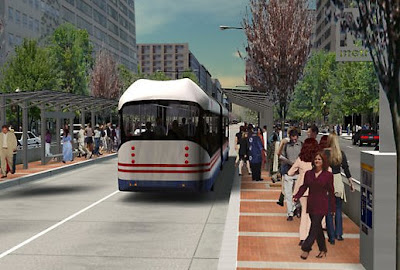


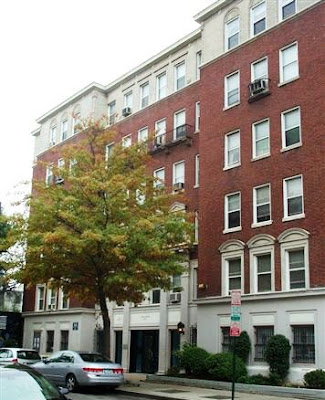
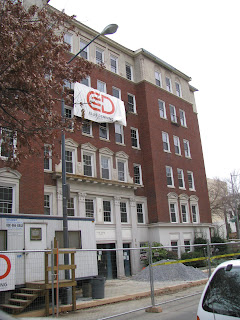


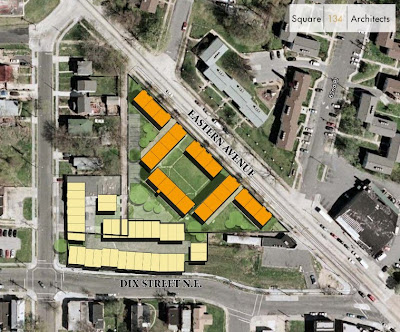








 The DC government initially set a due date of October 2, but changed the date in mid September to October 30th. No bids have been received to date. The District is seeking "creative proposals" that thoughtfully address the neighborhood's overall vision for the neighborhood - a plan that foresees safe, lively streets with a local retail center, and livelier Washington Circle, revamped to be more of a meeting place.
The process began with legislation in the summer of 2007 with an attempted sale to
The DC government initially set a due date of October 2, but changed the date in mid September to October 30th. No bids have been received to date. The District is seeking "creative proposals" that thoughtfully address the neighborhood's overall vision for the neighborhood - a plan that foresees safe, lively streets with a local retail center, and livelier Washington Circle, revamped to be more of a meeting place.
The process began with legislation in the summer of 2007 with an attempted sale to 











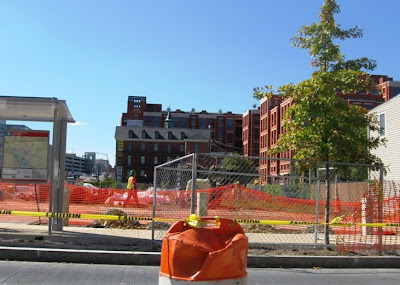 with neighborhood approval, calls for an anchor grocer and LEED- certified rental units, and will continue the reinvigoration of a corridor already known for its burgeoning restaurant, bar and entertainment scene.
with neighborhood approval, calls for an anchor grocer and LEED- certified rental units, and will continue the reinvigoration of a corridor already known for its burgeoning restaurant, bar and entertainment scene.







 The
The 


